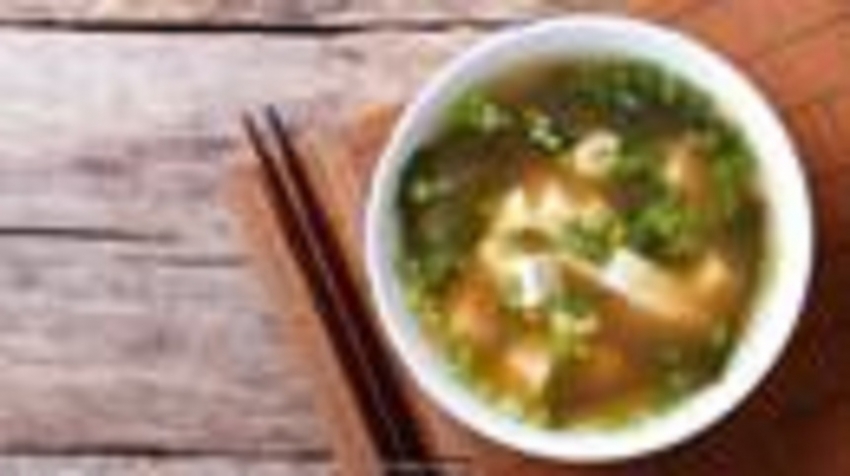Soy's isoflavones have oestrogenic properties — and have been blamed for raising the risk of breast cancer (as well as prostate cancer for men). But is this really the case?
By Jessica Brown
Consumed in many traditional Asian populations for millennia, soya has only been a common part of the Western diet for around 60 years. Now, many of our supermarkets are full of soy milk alternatives, soy burgers and other soya-based meat replacements – not to mention traditional soy-based products like tofu, tempeh, soya milk, miso and soya sauce.
In the meantime, soya has been linked to a lower risk of heart disease compared to other diets. As a good source of protein, unsaturated fatty acids, B vitamins, fibre, iron, calcium and zinc, it is becoming increasingly popular in the West as a healthy substitute for meat. But despite more people associating soya with health over the last decade, one fear has come to the fore: the idea that soya can disrupt our hormones.
The controversy around soya comes down to its uniquely high content of isoflavones. These compounds have oestrogenic properties, which means they act like oestrogen, the primary female sex hormone, and bind to oestrogen receptors in the body – and oestrogen can fuel the growth of some types of breast cancer.
But while scientists have extensively researched the compound’s effects in the body over the last few decades, the answer about whether isoflavones themselves can contribute to cancer risk isn’t straightforward.
And often, it seems soya protects against cancer risk – rather than making it worse. But exactly why that is isn’t certain.
You might also like:
• Is juicing actually good for you?
• The truth about the nitrates in your food
• Why you shouldn’t trust your food cravings
To start, there are the observational findings. High soya intake among women in Asian countries has been linked to their 30% lower risk of developing breast cancer compared to US women, who eat much less soya. (The average person’s intake of isoflavones in Japan, for example, is between 30 and 50mg, compared to less than 3mg in Europe and the US.)
Soya also has been correlated with reducing breast cancer’s severity. Fang Fang Zhang, associate professor at Tufts University in Massachusetts, carried out population research among 6,000 women with breast cancer living in the US and found a 21% reduction in mortality among those who consumed more soya.
Population research among 6,000 women with breast cancer found a 21% reduction in mortality among those who consumed more soya
Its benefits were strongest in women with hormone-receptor-negative breast cancer, a more aggressive type of breast cancer where tumours lack oestrogen and progesterone receptors, and therefore doesn’t respond well to hormone therapies.
“Our findings suggest that, for women with hormone-receptor-negative breast cancer, soya food consumption may potentially have a beneficial effect to improve survival,” Zhang says.
Not soy easy
Even so, it’s difficult to conclusively isolate soya’s benefits – if there are any.
Soya is often consumed as part of a healthy diet and as a substitute for red meat, which is associated with a higher risk of heart disease and cancer.
“No one has given people soya foods, then looked at whether they’re more or less likely to get breast cancer over time than those not given soya,” says Leena Hilakivi-Clarke, professor of oncology at Georgetown University School of Medicine in Washington DC.
One review of evidence into soya’s effect on breast cancer risk found that studies that adjusted for body mass index (BMI), a common marker of health, showed a weaker association for soya than those that didn’t.
This means a reduced risk of breast cancer could have been due to lower BMI, not to soya consumption.
If soya does lower breast cancer risk, it may be because its isoflavones can enhance apoptosis: a genetically programmed mechanism that tells cells to self-destruct when they get DNA damage they’re not able to repair. Without this process, damaged cells can form into cancer.
So where did the concern that soya causes cancer come from?
It’s true that soya has been found to fuel the growth cancer cells in lab research. In one experiment from 2001, mice with inhibited immune systems and with cancerous tumours were fed isoflavones. Their tumours were measured for 11 weeks. The researchers found that the isoflavones resulted in increased cell growth. The mice were then switched to an isoflavone-free diet – and their tumours regressed over the following nine weeks. Meanwhile, in a study from 1999, researchers implanted human breast cancer cells into mice, and some were fed isoflavones. They also found that dietary isoflavones enhance the growth of cancerous tumours.
But a more recent, 2010 review of more than 100 studies concluded that, overall, lab experiments have shown no significant increased risk of breast cancer.
One reason there isn’t a more definitive answer is because isoflavone either acts like oestrogen in the body, or its opposite
One reason there isn’t a more definitive answer is because isoflavone either acts like oestrogen in the body, or its opposite. When we eat soya, isoflavone either binds to the alpha oestrogen receptor in the body, which stimulates a tumour’s growth rate, or the beta receptor, which decreases growth rate and induces apoptosis.
Isoflavone prefers to bind to beta receptors, says Bruce Trock, professor of epidemiology and oncology at Johns Hopkins School of Medicine in Maryland in the US. That makes it more likely to reduce potential cancer risk.
The impact of soya on breast cancer risk may depend on when we start eating it.
Most studies on Asian populations included women who have eaten it since early childhood and were probably also exposed to it in the uterus, says Trock, compared to Western studies involving women who mostly didn’t eat soya until later in life.
“Giving soya to animals at the equivalent of middle age doesn’t seem to reduce risk or growth rate of tumours,” he says.
“But if researchers feed mice [soy] prior to puberty, then expose them to carcinogens, they get fewer and smaller tumours than if you don’t give them soya.”
Soya cycle
Meanwhile, clinical and population data shows daily soya intake can halve the frequency and severity of hot flashes even when the placebo affect is taken into consideration, says Mindy Kurzer, professor of nutrition at the University of Minnesota. (Taking oestrogen medication, on the other hand, brings hot flushes down by 75%.)
Some research has found that these benefits are largely determined by a woman’s ability to produce equol, a bacteria that around 30 to 50 percent of adults produce in their intestines after eating soy. One study found that giving equol supplements to menopausal women who don’t produce it themselves significantly lowered the incidence and severity of hot flushes.
It could be that a person’s ability to produce equol, rather than the equol itself, is responsible for the benefits of soya. One paper argues that Chinese populations, for example, may be better able to digest and extract nutrients from soya because their ancestors have been eating it for thousands of years.
This could explain why research has found that, while people who move from Asian countries to the US have an increased risk of breast cancer by the second generation, their risk remains lower than Westerners even when they adopt a Western diet.
Early soya intake has also been found to reduce the risk of cardiovascular disease. In fact, population studies suggest isoflavone intake could be responsible for the different rates of cardiovascular disease between Asian and Western countries. This is because soya has been found to reduce levels of harmful low-density lipoprotein (LDL) cholesterol in the blood, which is a risk for heart disease.
But may have nothing to do with soya, per se – it could simply be because diets higher in soya are lower in unhealthier foods.
“Soya foods are normally eaten in place of other higher saturated fat foods, such as fatty meat and full-fat dairy products,” says JoAnn Pinkerton, professor of obstetrics and gynaecology at the University of Virginia Health System. “Whereas most soya foods are naturally low in saturated fat.”
There are also concerns soya could be linked to prostate cancer. However, a review of evidence last year found that regular soya food intake was associated with an almost 30% reduction in risk of developing prostate cancer. Soya doesn’t affect testosterone levels in men, so how this happens isn’t yet known – except that a diet containing more soya is often healthier overall.
We maintain the current conclusion that soya is beneficial in preventing prostate cancer – Catherine Applegate
“Throughout the years and despite the constant emergence of new research that could contain potentially conflicting results, we maintain the current conclusion that soya is beneficial in preventing prostate cancer,” says the study’s author Catherine Applegate, a predoctoral fellow from the University of Illinois's Tissue Microenvironment Training Program.
Soya’s benefits also depend on the type we consume. Isoflavone content varies in unprocessed soybeans, such as edamame beans, compared to processed soya foods – and the closer the food is to the soyabean, the higher its isoflavone levels. Edamame has around 18mg of isoflavones per 100g, while soya milk has between 0.7 and 11mg.
“The only thing we can say is that women should be safe to consume soya foods in amounts consistent with Asian diet, including tofu, fermented soya foods and soymilk, but studies shown that the more soya is processed, the lower the level of isoflavones, which we think are protective elements,” says Trock.
Soya has been extensively researched over the last few decades. No single study has been perfect, and as with other nutritional research, findings often show correlation – they don’t prove causation.
Even so, the consensus clearly indicates health benefits from eating soya – even if that’s simply because it replaces unhealthier foods.
Food Fictions Nutrition
Is juicing actually good for you?
Many of us see fresh fruit juice as a healthy way to get a mega-dose of vitamins – but is that true? And what does it do to our blood sugar and insulin levels?
By Jessica Brown
2 January 2019
Freshly juiced fruit has become a staple in many diets – especially those of busy, health-conscious consumers who can save time on making (and perhaps even chewing) their food without missing out on nutrients. Fruit juice also has been linked to claims that it can help you both lose weight, and ‘detox’ your system.
All of which, of course, has made it highly lucrative. The global fruit and vegetable juices market was valued at $154 billion (£123bn) in 2016 and is expected to grow.
But is juicing really as healthy as we think?
You might also like:
• Is breakfast the most important meal of the day?
• Are you eating enough salt?
• Cold remedies: Old wives’ tales… or legitimate science?
Most foods containing fructose – a naturally occurring sugar found in all fruits and fruit juices – don't seem to have harmful effects as long as they're not contributing to excess daily calories. This is because the fibre found in whole fruits is intact, and the sugar is contained within the fruit's cells. It takes our digestive system a while to break these cells down and for fructose to enter the bloodstream.
But this is not the case with fruit juice.
Fibre mechanics
“Fruit juice has most of the fibre removed,” says Emma Elvin, senior clinical advisor at the charity Diabetes UK. This is why, unlike whole fruit, the fructose in fruit juices counts as ‘free sugars’ – which also include honey and the sugars added to foods. It’s recommended by the World Health Organisation that adults have no more than 30g of added sugar, the equivalent of 150ml of fruit juice, per day. (Read more in our recent story about whether sugar really is bad for you).
The problem is that, with the fibre removed, fruit juice’s fructose is absorbed more quickly. Sudden spikes in blood sugar cause the pancreas to release insulin to bring it back down to a stable level. Over time, this mechanism can wear out, increasing the risk of developing type 2 diabetes. In 2013, researchers analysed the health data of 100,000 people collected between 1986 and 2009 and found that fruit juice consumption was linked with increased risk of type 2 diabetes. They concluded that – since liquids pass through the stomach to the intestine faster than solids – even when the nutritional content is similar to whole fruit, fruit juice leads to faster and larger changes in glucose and insulin levels.
Another study found a relationship between fruit juice and type 2 diabetes after following the diets and diabetes status of more than 70,000 nurses over 18 years. The researchers explain that the possible reason for this may partly have been the lack of the other components found in whole fruit, like fibre.
Juices containing vegetables can provide more nutrients and less sugar than juices made up of just fruit – but they still lack valuable fibre. Diets high in fibre have been linked to a lower risk of developing coronary heart disease, stroke, high blood pressure and diabetes, and it's recommended adults consume 30g per day.
Overall excess
Aside from the link to type 2 diabetes, many studies agree that fruit juice is harmful if it contributes to an excess in calories.
In an analysis of 155 studies, John Sievenpiper, associate professor at the University of Toronto's Department of Nutritional Sciences, set out to understand if the associations between sugary soft drinks and health – including risk of diabetes and cardiovascular disease – were applicable to the food and drink we generally consume as part of a healthy diet. He compared studies looking into the effects of fructose-containing sugars (including sucrose, high fructose corn syrup, honey and syrups) with control diets free from or lower in these sugars. His aim? To isolate the effects of consuming too many calories from the effects of foods containing different sugars.
He found negative effects to fasting blood sugar and insulin levels when food provided excess calories from sugars, including fruit juice. However, when the calories weren't in excess overall, there were some advantages to consuming whole fruit – and even fruit juice. Sievenpiper concludes that the recommended 150ml of fruit juice per day, which is an average serving, is reasonable.
The paper concluded that foods containing fructose may have some small benefits for long-term blood sugar control when they don’t lead to over-consumption of calories. But when they do lead to too many calories, they risk raising blood sugar and insulin levels. This could be because fructose has a relatively low GI, the paper states, while high GI diets are associated with insulin resistance.
"Getting a whole fruit is better than fruit juice, but if you're going to use juice as a complement to fruits and vegetables, that's fine – however, not if you're using juice for hydration and drinking large amounts," Sievenpiper says.
So while we know that fruit juice can cause diabetes if it’s part of a diet that’s more calorific overall, it's less clear how juice affects the long-term health of those who aren't overweight.
"There's still a lot we don't understand about how having increased sugar in the diet without weight gain changes risk," says Heather Ferris, assistant professor of medicine at the University of Virginia. "For how long and well the pancreas can keep up with the sugar is partly down to genetics."
But we have a higher risk of consuming more than the recommended daily number of calories (around 2,000 for women and 2,500 for men) on the days we drink juice, according to research. Numerous studies have shown that drinking fruit juice doesn't make us consume any less of other foods throughout the day.
“It’s also easy to consume large amounts of fruit juice quite quickly, meaning extra calories. And when calories increase, this can contribute to weight gain,” Elvin says.
With a twist
But one study published last year may have found a way to make juicing healthier. Researchers used a 'nutrient extractor’ blender that, unlike traditional juicers, juices the whole fruit, including seeds and skin. They measured the effects of mixed fruit and peeled mango – both of which rank highly on the glycaemic index and therefore cause a spike in blood sugar – juiced in a nutrient extractor blender, compared with another group who ate the same fruit whole.
Those who drank nutrient-extracted mixed fruit had a lower blood sugar increase compared with the whole mixed fruit group, while there were no differences between those who had mango juice and whole mango.
However, this was a small study, and the researchers didn’t compare their findings with juice made by any other method, such as squeezing out the juice and leaving the skin and seeds.
Gail Rees, senior lecturer in human nutrition at the University of Plymouth and researcher on the study, says the findings were probably caused by the fruit seeds contained in the juices. But she says it’s difficult to offer clear advice from this study.
"I'd certainly go along with the current advice of 150ml of fruit juice per day, but if you do use a nutrient extractor at home, it could be keeping blood sugar levels relatively stable," she says.
But while keeping seeds in the juice may make some difference during digestion, Ferris argues this doesn't necessarily change how filling the juice is.
"When the juice includes some fibre it will slow down absorption, but you still have excess calorie intake because it's easy to consume. However, it's an improvement over traditional fruit juice," she says.
Other ways we can improve the effects of fruit juice on our health include making sure we select ripe fruit to retain as much of its goodness as possible, according to Roger Clemens, professor of pharmaceutical sciences at the University of Southern California.
It's also important to recognise that different juicing methods are better suited to different fruit because of their physical make-up, Clemens has found. For example, most of the phytonutrients in grapes are found in the seed, with very little found in the pulp. And most of the beneficial phenolic and flavonoid compounds found in oranges are located in the peel, which is lost with traditional juicing.
Detox debunked
Another reason for fruit juice's recent popularity is the argument that it can help to detox the body.
However, the only medically recognised use of the word ‘detox’ refers to removing harmful substances from the body, including drugs, alcohol and poison.
"The whole concept of a juice diet being detoxifying is a fallacy," says Clemens. "We consume compounds every day that may be toxic and our bodies do a wonderful job of detoxing and eliminating everything we eat."
And juice isn’t a cure-all for getting your nutrients, either.
(Credit: Getty)
Nutrition
The truth about the nitrates in your food
Usually associated with processed meats, nitrates and nitrites are potentially cancer-causing compounds. But what are they, really – and are they always detrimental?
By Angela Dowden
13 March 2019
“Nitrates” may make you think of school chemistry lessons or fertilisers. They’re probably less likely to be something you’d associate with dinner.
If you do think of nitrates in the context of food, it is probably a negative image that comes to mind – in particular, perhaps, the recent call for nitrate and nitrite preservatives to be banned from bacon and ham because of potential cancer-causing effects.
But the relationship between dietary nitrates/nitrites and health is a lot more nuanced than merely saying “they’re bad for us”. For example, the high natural nitrate content of beetroot juice has been credited with lowering blood pressure and enhancing exercise performance. Nitrates are also the active ingredient in some medications for angina, a condition in which reduced blood flow causes chest pain.
So are nitrates and nitrites actually bad for us?
You might also like:
• Are any foods safe to eat anymore?
• We don’t need nearly as much protein as we consume
• Is a low-salt diet healthy?
Nitrates and nitrites, such as potassium nitrate and sodium nitrite, are naturally occurring chemical compounds which contain nitrogen and oxygen. In nitrates the nitrogen is bonded with three oxygen atoms, while in nitrites the nitrogen is bonded with two oxygen atoms. Both are legal preservatives which suppress harmful bacteria in bacon, ham, salami and some cheeses. (Read more about how cured meats protect us from food poisoning).
Only around 5% of nitrates in the average European diet come from processed meats, while more than 80% are from vegetables
From all the furore around processed meat, you may imagine it is the major source of nitrates in our diet. But in fact only around 5% of nitrates in the average European diet come from this source, while more than 80% are from vegetables. Vegetables acquire nitrates and nitrites from the soil they grow in – nitrates are part of natural mineral deposits, while nitrites are formed by soil microorganisms that break down animal matter.
Leafy greens like spinach and rocket tend to be top of the crop for nitrate content, with other rich sources include celery and beetroot juices, and carrots. Organically grown vegetables may have lower levels than non-organic vegetables as synthetic nitrate fertilisers aren’t used.
However, there’s an important difference between the way nitrates and nitrites are packaged in meat versus from vegetables – and that affects whether they’re carcinogenic, too.
Cancer connection
Nitrates are fairly inert by themselves, meaning they are unlikely to get involved in chemical reactions in the body. But nitrites, and the chemicals formed from them, are much more reactive.
Most of the nitrites we encounter aren’t consumed directly, but are converted from nitrates by the action of bacteria found in our mouth. Interestingly, research shows that use of an anti-bacterial mouth wash can massively cut down this oral manufacture of nitrites.
When the nitrites manufactured in our mouth are swallowed, one of the things that can happen is that they react in the strongly acidic environment of the stomach to form nitrosamines – some of which are carcinogenic and have been linked with bowel cancer.
But for this to happen, a source of amines, chemicals related to ammonia that are found abundantly in protein foods, is required. Nitrosamines can also be created directly in foods through high-heat cooking, as with fried bacon.
It’s not so much nitrates/nitrites that are carcinogenic, but the way they are cooked and their local environment – Kate Allen
“It’s not so much nitrates/nitrites per se [that are carcinogenic], but the way they are cooked and their local environment that is an important factor,” says Kate Allen, executive director of science and public affairs at the World Cancer Research Fund. “For example, nitrites in processed meats are in close proximity to proteins (specifically amino acids). When cooked at high temperatures this allows them to more easily form nitrosamines, the cancer-causing compound.”
But Allen adds that nitrites are just one reason processed meats contribute to bowel cancer, and their relative importance is uncertain. Other factors that may contribute include iron; PAHs (polycyclic aromatic hydrocarbons) which are formed in smoked meats; and HCAs (heterocyclic amines), which are created when meat is cooked over an open flame – and which also are tumour-promoting.
It’s also important to keep the dangers of processed meat in context. While the International Agency for Research on Cancer categorises processed meat a carcinogen, the risk is quite small.
In the UK, for example, six out of 100 people will get bowel cancer in their lives. Of those who eat 50 grams processed meat (about three rashers of bacon) daily, the chance is seven out of 100.
Good chemicals
Nitrites aren’t all bad. There’s increasing evidence they may provide cardiovascular and other benefits thanks to a molecule called nitric oxide.
In 1998, three US scientists received the Nobel prize for their discoveries around the role of nitric oxide – a gas – in the cardiovascular system. We now know it dilates blood vessels, lowers blood pressure and is part of the body’s armoury against infections. Limited capacity to produce nitric oxide is associated with heart disease, diabetes and erectile dysfunction.
One way the body makes nitric oxide is from an amino acid (a building block of protein) called arginine. But it’s now known that dietary nitrates can also significantly contribute to nitric oxide formation. We also know that this may be particularly important in older people, since natural nitric oxide production via arginine tends to drop with ageing.
While the nitrates found in ham are chemically identical to those in a salad, it’s the vegetable-based ones you should shoot for
Still, while the nitrates found in ham are chemically identical to those in the salad you might eat with it, it’s the vegetable-based ones you should shoot for.
“We have observed increased risks associated with nitrate and nitrite from meats for some cancers, but we haven’t observed risks associated with nitrates or nitrites from vegetables – at least in large observational studies where intake is estimated from self-reported questionnaires,” says Amanda Cross, a reader in cancer epidemiology at Imperial College, London.
Cross adds that it’s “a reasonable assumption” that nitrates in leafy greens are less likely to be harmful (ie to form nitrosamines). This is because they aren’t protein-rich foods and also contain protective components like vitamin C, polyphenols and fibre, which have all been shown to reduce nitrosamine formation.
When most of the nitrates in our diets come from vegetables – and in turn encourage nitric oxide formation – they are probably good for us
So when most of the nitrates in our diets come from vegetables – and in turn encourage nitric oxide formation – they are probably good for us.
One nitric oxide expert has gone further, arguing that many of us are deficient in nitrates/nitrites and that they should be classified as essential nutrients that can help prevent conditions such as heart attacks and strokes.
Right amount
It’s virtually impossible to reliably estimate dietary nitrate intake because content in food is hugely variable. “Levels can vary up to 10,000-fold for lettuce, and nitrates within drinking water can also vary considerably within the legal limit (50mg/litre),” says nutritional epidemiologist Gunter Kuhlne of the UK’s Reading University.
“It means that studies investigating the effects of nitrate on health need to be interpreted very carefully, as ‘nitrate’ might simply be a marker of vegetable intake”.
A 2017 European Food Safety Authority (EFSA) report endorsed an Acceptable Daily Intake or ADI (the amount that can be consumed over a lifetime without appreciable health risk) that equates to 235mg of nitrate for a person weighing 10 stone (63.5kg/140lb). But the report also noted that people of all age groups can exceed this ADI quite easily.
Nitrite intakes are generally much lower (one estimate of average intake in the UK being 1.5mg per day), and EFSA says exposure to nitrite preservatives is within safe levels for all population groups in Europe, except for a slight exceedance in children with diets high in the additives.
Some experts contend that nitrate/nitrite ADIs are outdated anyway, and that higher levels are not only safe but actually beneficial – as long as they come from vegetables, not processed meats.
Having 300-400mg of nitrates in one go – potentially provided by a large rocket and spinach salad, or a beetroot juice shot – is the amount that’s been linked with falls in blood pressure, for example.
As always, dose makes the poison, and levels of 2-9 grams (2000-9000mg) of nitrate can be acutely toxic, causing changes in haemoglobin that present as a blueish tinge to lips and skin. But that would be a difficult level to reach in one sitting, and very unlikely to happen from food itself – it’s more of a risk from, say, exposure to fertiliser-contaminated water.
The upshot? If you want to eat the right kinds of nitrates and nitrites and avoid the potentially carcinogenic ones, then eat a widely varied diet with at least five servings a day of fruit and vegetables, and avoid nibbling on processed meats too often. That way, the benefits of nitrates and nitrates will almost certainly outweigh the downsides
News
Sport
Reel
Worklife
Travel
Future
More
Search the BBC
Search
Search the BBC
Future
What is BBC Future?
Latest
Best of..
NEW SERIES
Follow the Food
TOMORROW'S TRENDS
Future Now
Cravings probably don’t reflect what our body needs (Credit: Getty Images)
Food Fictions Nutrition
Why you shouldn't trust your food cravings
Many of us believe that a food craving is our body’s way of signalling that it needs a certain nutrient. But research shows that’s unlikely to be true – with one possible exception.
By Jessica Brown
28 May 2019
When we’re hungry, just about any food will do, but a craving can leave us fixated on a particular food until we get our hands, or indeed mouths, on it.
Most of us know what it feels like to experience food cravings. We usually crave higher calorie foods, which is why cravings are associated with weight gain and increased body mass index (BMI). But the story we tell ourselves about where these cravings come from could determine how easily we give into them.
It’s widely believed that cravings are our body’s way of signalling to us that we’re deficient in a certain nutrient – and for pregnant women, their cravings signal what their baby needs. But is this really true?
You might also like:
• Is breakfast really the most important meal of the day?
• Is sugar really bad for you?
• How much water should you drink a day?
Much of the research into cravings has instead found that there are probably several causes for cravings – and they’re mostly psychological.
Cultural conditioning
In the early 1900s, Russian scientist Ivan Pavlov realised that dogs anticipated food in response to certain stimuli associated with feeding time. In a series of well-known experiments, Pavlov taught the dogs to respond to the sound of a bell by drooling.
Food cravings largely can be explained by this conditioning response, says John Apolzan, assistant professor of clinical nutrition and metabolism at Pennington Biomedical Research Center.
“If you always eat popcorn when you watch your favourite TV show, your cravings will for popcorn will increase when you watch it,” he says.
The 15:00 slump is another example of this response in practice. If you crave something sweet in the middle of the afternoon, there’s a chance this craving is stronger when you’re at work, says Anna Konova, director of the Addiction and Decision Neuroscience Laboratory at Rutgers University in New Jersey.
That is because cravings arise from particular external cues, rather than our body calling out for something.
Chocolate is one of the most common food cravings in the West – which supports the argument that cravings don’t stem from nutritional deficiencies, since chocolate doesn’t really contain high levels of anything we could be deficient in.
It’s often argued that chocolate is such a common craving because it has high amounts of phenylethylamine, a molecule that triggers the brain to release feel-good chemicals dopamine and serotonin. But many other foods we don’t crave nearly as often, including dairy products, contain higher concentrations of this molecule. Also, when we eat chocolate, an enzyme breaks the phenylethylamine down, so it doesn’t go into the brain in significant quantities.
Chocolate, which is craved twice as much among women than men, has been found to be the most craved food in the West by women before and during menstruation. But while blood loss can increase the risk of some nutritional deficiencies, such as iron, scientists say chocolate wouldn’t restore iron levels anywhere near as quickly as red meat or dark, leafy greens.
One would assume that, if there was any direct hormonal effect causing a biological need for chocolate during or before menstruation, this craving would alleviate after the menopause. But one study only found a small decrease in the prevalence of chocolate cravings in post-menopausal women.
It’s much more likely that the association between PMS and chocolate cravings is cultural, due to its prevalence in Western society. One study found that women born outside the US were significantly less likely to link chocolate cravings to the menstrual cycle, and experienced fewer chocolate cravings, compared to those born in the US and to second-generation immigrants.
Women might associate chocolate with menstruation, researchers have argued, because during and before their periods is the only time they feel it’s culturally acceptable for them to eat “taboo” foods. This, they say, is because Western culture has a “thin ideal” of female beauty that creates the perception that craving chocolate must be justified with a good excuse.
Another paper argues that food cravings are caused by the ambivalence or tension between desiring a food and wanting to control food intake. It’s assumed, the paper states, that women in particular resolve this by not having the food in question – which increases their chance of craving it as they’re more likely to notice cues.
This can be problematic, Hill says, because cravings are fuelled by negative feelings.
“If eating a craved food follows a craving, then those restricting what they eat to lose weight will feel they've broken a dietary rule and feel bad about themselves,” he says.
“We know from studies and clinical observations that negative mood can trigger more eating and, for some, become an eating binge. This pattern has little to do with a biological need for food or physiological hunger. Rather, it's the rules we set regarding eating and the consequences of their transgression.”
Only two-thirds of languages have a word for cravings
Research also indicates that, while chocolate cravings are prevalent in the West, they’re not common at all in many Eastern countries. There are also differences in how urges for different foods are communicated and understood; only two-thirds of languages have a word for cravings, and in most cases, this word only relates to drugs, and not food.
“When you can articulate that a craving exists, you can identify and define it, which means you can experience it,” says Nicole Avena, assistant professor of neuroscience at the Mount Sinai School of Medicine in New York.
“Having a definition means cravings are real, whereas if cravings aren’t well defined or ingrained in a culture, people won’t automatically assume cravings are happening to them – they’re more elusive.”
Even in languages that do contain a word for craving, there is still is a lack of consensus around what a craving actually is. This, Konova argues, is a barrier to understanding how to overcome cravings, since we may be labelling several different processes as cravings.
Microbe manipulation
There is evidence suggesting that the trillions of bacteria in our guts can manipulate us to crave, and eat, what they need – which isn’t always what our body needs.
This is because microbes are looking out for their own interests, says Athena Aktipis, assistant professor at Arizona State University’s department of psychology. And they’re good at doing this.
“The gut microbes that are best at surviving inside us end up being more frequent in the next generation. They have the evolutionary advantage of being better at affecting us in ways that get us to preferentially feed them,” she says. (Find out more about how microbes affect our bodies in our recent BBC Future series Microbes and Me).
Different microbes in our guts prefer different environments, such as more or less acidic, and what we eat affects the ecosystem in our guts and what’s available for the bacteria to survive on. They can manipulate us into eating what they need in a few different ways.
They can send signals from the gut to the brain via our vagus nerve and make us feel under the weather if we’re not eating enough of a certain nutrient, or make us feel good when we eat what they want, by releasing neurotransmitters such as dopamine and serotonin. They can also alter our taste receptors so we consume more of something to get the same taste of sweetness, for example.
No one has observed this happening yet, Aktipis says, but it’s based on scientists’ understanding of how microbes behave.
But, she adds, these microbes aren’t always necessarily signalling for us to eat things that are good for us. After all, some bacteria cause disease and death.
“There’s a notion that the microbiome is part of us, but if you have an infectious disease making you feel sick, you would say that microbe is invading your body, not that it’s part of your body,” she says. “You could be getting hijacked by an impaired microbiome.”
But if you eat a diet with lots of complex carbohydrates and fibre, you will cultivate a more diverse microbiome, Aktipis says. This probably means that a healthy diet, which leads to a healthy microbiome, means you crave healthy food.
Cut your craving
Since our environment is full of cues that could tap into our cravings, such as advertising and photos on social media, overcoming them isn’t so straightforward.
“Everywhere we go, we see adverts for food with lots of added sugar, and it’s easy to access these foods. This continual bombardment of advertising affects the brain – and smelling these foods primes the brain to want to eat them,” says Avena.
Since there’s no realistic way to reduce the stimulus of something like chocolate in an environment where we’re surrounded by it, researchers are studying how we can overcome the conditional model of cravings using cognitive strategies instead.
A number of studies have found that mindfulness techniques, such as being aware of cravings and not judging these thoughts, can help reduce cravings overall.
One of the most effective ways to curb cravings is to cut the craved food from our diet
Research has found that one of the most effective ways to curb cravings is to cut the craved food from our diet – which runs counter to the argument that we crave what we need.
In one study, researchers carried out a two-year trial where they randomised more than 300 subjects to one of four diets with different levels of fat, protein and carbohydrates, and measured their cravings and food intake. All the groups lost weight, but when they ate less of a certain food they craved it less.
The researchers say their findings show that, in order to reduce cravings, people should eat the food they crave less often – possibly because our memories associated with that food fade over time.
It’s largely agreed that more work needs to be done into defining and understanding cravings, and developing ways we can overcome the conditional response we develop for unhealthy food. In the meantime, there are several mechanisms suggesting that the healthier our diet, the healthier our cravings.




















